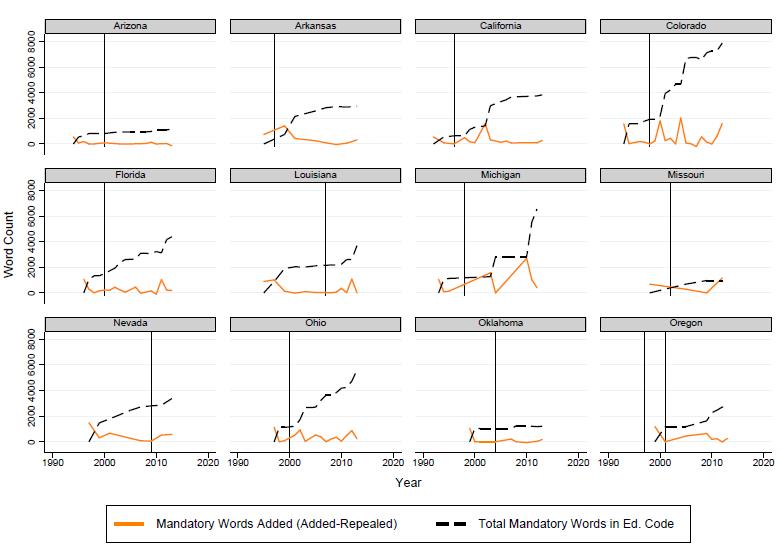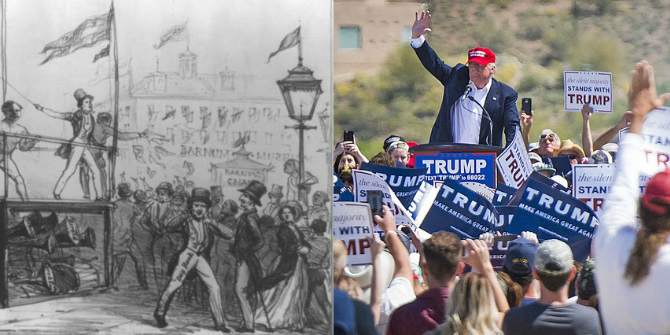 Many state legislators, like the President and 36 state governors, are term-limited. But what effects do these limits have on the way state legislators govern? In new research which examines legislative oversight by term-limited state representatives, Mona Vakilifathi argues that term limits motivate legislators to make laws which tie the hands of state bureaucrats to implement policies in line with legislators’ policy goals.
Many state legislators, like the President and 36 state governors, are term-limited. But what effects do these limits have on the way state legislators govern? In new research which examines legislative oversight by term-limited state representatives, Mona Vakilifathi argues that term limits motivate legislators to make laws which tie the hands of state bureaucrats to implement policies in line with legislators’ policy goals.
Legislative term limits are frequently discussed as both a solution and a problem in US national and state politics. In October 2016, then presidential candidate Donald Trump made a pledge to propose a constitutional amendment to enact legislative term limits for House Representatives and Senators in Congress. According to his Contract with the American Voter, the enactment of term limits will reduce corruption and special interest group capture. Speaker Paul Ryan publicly supported legislative term limits in November 2016 but Congress has not taken any action on the issue since.
In September 2017, the Michigan Chamber of Commerce announced it is considering a constitutional amendment to modify Michigan’s legislative term limits laws through the initiative process in the fall 2018 state election. With a two-term limit for state Representatives and three-term limit for state Senators, according to The Detroit News and MLive, the Michigan legislature will be subject to the highest state legislator turnover in the United States after the 2018 election: seventy percent of Michigan state Senators and twenty percent of Michigan state Representatives will be termed-out of their current positions in 2019. The initiative generally intends to address the expected turnover and other reported negative effects of term limits on lawmaking.
Past research demonstrates the negative effect of legislative term limits on state legislators’ engagement in lawmaking and bureaucratic oversight. Term-limited legislators are less likely to enact complex legislation or engage in bureaucratic oversight activities, such as committee hearings or audits, than their counterparts in other state legislatures without term-limits. However, other research has shown that state agency leaders report term-limited legislators as more influential in the lawmaking process than their counterparts. How do we make sense of these conflicting findings?
I argue that legislative term limits motivate legislatures to engage in lawmaking to a greater extent to ensure that the bureaucracy implements programs in accordance with legislative intent. Once a state enacts legislative term limits, legislators are more likely to engage in lawmaking to signal that they are effective legislators to current and future constituents (when legislators run for another elected office) within their finite terms. Term limits prevent legislators from using bureaucratic oversight because they are in office for a finite number of years. Therefore, legislators are more willing to incur the time and resources to write detailed statutes to ensure that the bureaucracy will implement programs in accordance with the legislator’s intent long after they are termed-out of office. Overall, legislatures are less likely to grant statutory discretion, the degree of policy discretion granted in a state’s statutes, to the bureaucracy once a state enacts legislative term limits.
By Steve & Christine from USA CC BY 2.0, via Wikimedia Commons
I verify this argument by comparing a state’s average statutory discretion on one policy issue – charter school authorization, renewal, and revocation – before and after the enactment of legislative term limits from 1991 to 2013. According to the National Conference of State Legislatures, sixteen states enacted legislative term limits: Arizona, Arkansas, California, Colorado, Florida, Louisiana, Maine, Michigan, Missouri, Montana, Nebraska, Nevada, Ohio, Oklahoma, Oregon (1997-2001), and South Dakota. Unlike other policy areas, we can leverage the intrastate variation for twelve of the sixteen states with legislative term limits in the charter school context. Charter schools are public K-12 schools that are granted more policy flexibility by state governments than traditional public K-12 schools. Charter school authorization, renewal, and revocation pertains to the criteria and procedures a charter school authorizer (e.g., local school boards of education) must execute when deciding whether to open or close a charter school.
I measure statutory discretion by counting the number of mandatory words added to a state’s charter school authorization, renewal, and revocation statutes. I collected more than 6,500 sentences on this topic across forty-two states with charter school laws from 1991 to 2013. I then used automated text analysis to code whether or not the sentence had an optional or mandatory phrase. An optional phrase authorizes the subject of a statutory sentence to execute a procedure whereas a mandatory phrase legally requires the subject to execute a procedure. I then looked at the relationship between this measure of statutory discretion with two measures of legislative term limits.
As Figure 1 shows, once a state enacts legislative term limits, the legislature decreases the degree of statutory discretion granted to the bureaucracy. The scatterplots illustrate the within-state trends for the dependent variable, the number of mandatory words added minus repealed, before and after a state enacts legislative term limits. The main results, which include other prominent explanatory factors of charter school statutory discretion, show that once a state enacts legislative term limits, the legislature adds 21 percent more mandatory words to its charter school authorization, renewal, and revocation statutes. In addition, a one percent increase in the percent of term-limited legislators in their final term adds 0.94 percent more mandatory words to a state’s statutes.
Figure 1 – Legislative term limits and mandatory words in legislation

Note: The vertical line indicates the first year of impact. For Oregon, the second vertical line indicates the last year of enactment.
My results suggest that President Trump, or any president or governor, should be careful what he wishes for when he campaigns for legislative term limits. The enactment of legislative term limits motivates legislators to grant less statutory discretion to the bureaucracy than their counterparts. A decrease in statutory discretion limits the executive’s control over the bureaucracy’s policy implementation. A short-sighted legislator binds the bureaucracy, and indirectly the executive, long after the legislator is termed out of his or her seat.
- This article is based on the paper, ‘Constraining Bureaucrats Today Knowing You’ll Be Gone Tomorrow: The Effect of Legislative Term Limits on Statutory Discretion’ in Policy Studies Journal.
Please read our comments policy before commenting.
Note: This article gives the views of the author, and not the position of USAPP – American Politics and Policy, nor the London School of Economics.
Shortened URL for this post: http://bit.ly/2zbKlHY
_________________________________
About the author
 Mona Vakilifathi – New York University
Mona Vakilifathi – New York University
Mona Vakilifathi is an Assistant Professor in the Robert F. Wagner Graduate School of Public Service at New York University. Her research interests include US state politics, lawmaking, and charter schools.







